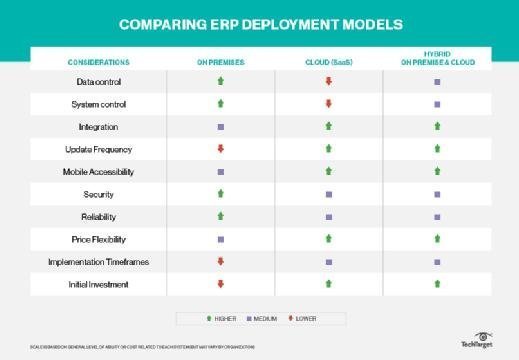
everythingpossible - Fotolia
Cloud ERP system selection: How to evaluate your company needs
This article can help you evaluate your business needs and make sure you're getting the right cloud ERP system for your organization.
It is a challenge for organizations to choose the ERP system that will best meet their needs. There are myriad ERP platforms, all with similar fundamental goals, but each with its own functional nuances. Couple this with the growing popularity of cloud computing, and it's no wonder many companies are struggling to decide whether to implement ERP software, much less cloud ERP software.
To select the right cloud ERP software, it can be beneficial to use a systematic, logical methodology to evaluate the software. Companies can use this system, as well as the following techniques as a guide to help them choose the optimal cloud ERP system.
What's the IT strategy?
Before selecting a new ERP system, it is important to understand your enterprise's direction. Start the evaluation by identifying the organization's needs and functional requirements. By outlining and defining these, you can begin to see the expected business outcome from a new cloud ERP platform. Is the company in high growth mode? Is customer focus the driving force? Or are excessive costs overwhelmingly taking over?
Use organizational goals to get a better understanding of the capabilities needed to run the business. Then, compare this with the current IT landscape to identify gaps and rationalize or replace current applications, as well as to justify ERP budgets, schedules and priorities.
One effective self-evaluation method is to gather and elicit business requirements. These often derive from processes, regulations and internal business rules. Functional requirements are composed of processes with inputs and outputs.
For example, to process a purchase order, a user may need to receive and approve POs remotely on a mobile device with access to the cloud ERP. Regulatory requirements may include sufficient compliance standards, such as with the Payment Card Industry Data Security Standard or the Health Insurance Portability and Accountability Act, that protect sensitive data stored in the cloud. Often, internal business rules establish policies that the company already maintains, such as software pricing and hardware compatibility.
It's also important to document and validate any unique processes that could be competitive advantages in case the organization needs to do any customizations. Because the ability to customize a cloud ERP system, particularly SaaS, is limited, organizations should remain open to adopting the software's best practices out of the box. Without proper balance between functionality and adoption, implementation time frames and costs could suffer.
Do the homework
Organizations often overlook the fact that they aren't just buying the software, they're also buying the vendor and its services. In addition to purchasing an ERP platform directly from a software provider, the business can also turn to value-added resellers (VAR). VARs are companies that can add functionality or services to the software and sell the entire package as a comprehensive tool or more fine-tuned product.
Software vendors and VARs have specific application knowledge and can help find problem-solving capabilities within the ERP system using their professional services. Along with implementation, VARs can assist with integration, customization and training.
Many VARs collaborate with software providers and have varying levels of certification that reflect their expertise with that software provider's program or tool. Most companies looking at ERP systems generally ask if vendors have similar clients and opportunities, but vendor evaluation should go beyond the basics.
It's critical to perform due diligence to determine if a vendor has longer-term viability. Pay attention to the research of ERP vendors by analyst firms and consulting companies. It is also important to be aware of vendor details, including how much a company invests in research and development for its products and services.
Always clarify what a vendor is actually offering. If it's an on-premises ERP with cloud options, is it really a cloud ERP system, or is it just a traditional ERP system with remote access? Ask what modules or applications are available and then determine if the vendor offers the functionality you need. Businesses must compare the vendors and their products, as only then can they determine which best aligns with their business requirements.
Service-level agreements can vary
There's more to a service-level agreement (SLA) than simply understanding what a company is getting for their money. Support offered by vendor SLAs can have different levels that come with different terms, conditions and flexibility. A clearly defined SLA can also offer protection between an organization and a cloud ERP vendor should a dispute arise.
It's important to have discussions about what each vendor offers in terms of availability and uptime to set a standard expected level of performance with clear metrics for accountability. It's also vital to understand any compliance needs and what the vendor offers for security parameters. Companies should negotiate the necessary protection levels and understand the responsibilities in terms of data ownership, management and recovery.
It's also critical to review scalable pricing. Terms should dictate the prices for adding or removing users, as well as any potential fees associated with either scenario. It is important to be wary of any initial discounts because the vendor will most likely eventually increase prices. Avoid getting into a situation in which the company's only option is to pay increasing rates or move to another cloud ERP system.
Like any other system, it's important to know the total cost of ownership and not just the subscription rates. Businesses can crunch the numbers for other add-on fees, such as integration, data, and professional services, including implementation and ongoing customer support. Many of these costs are negotiable, so companies shouldn't consider the initial pricing the only concern.
Implementation planning and training
Relationships with cloud ERP vendors are generally long term, so it's wise to get an idea of how the vendor implements its software and services. The company may also want to explore whether it should use a big-bang approach -- one initial implementation of all the areas -- or a phased rollout. This may hinge on the size of the organization, the ERP modules selected and the priorities that align with the enterprise strategy.
Integration can be a major concern depending on which systems a company wants to retain or purchase in conjunction with a cloud ERP system. For areas that aren't being integrated, there should be a plan to migrate data to the new system. The cloud ERP vendor should discuss the integration protocols and data migration tools available. Companies can also ask vendors to see examples of similar integrations or migrations prior to choosing an ERP platform.
The table below compares the relative level of ability per consideration. For example, there is a higher degree (green arrow) of data control with on-premises ERP software, whereas SaaS ERP generally doesn't offer much data control (red arrow). For implementation time frames, on-premises implementations generally take longer (red arrow) than cloud or hybrid (blue square) implementations.
No one type of hosting is better than the other for ERP software. What works for one company can be unnecessary or detrimental for another.

Training and support tend to be leading areas of interest, especially for end users. Organizations should understand what resources are available for users to hone their skills. Many providers offer FAQs, manuals, and remote and on-site training programs. Several vendors also offer extended customer support, although there may be additional costs.
Cloud ERP selection doesn't have to be difficult
Selecting a cloud ERP system can be a daunting process, but it doesn't have to be. With so much at stake with such a large investment, it's crucial that an organization perform a comprehensive selection process.
A company can avoid most common pitfalls with a solid selection methodology coupled with the right experience and expertise. This can help increase the chances of choosing the right software and ultimately having a successful cloud ERP implementation.
Linda Rosencrance contributed to this report.








